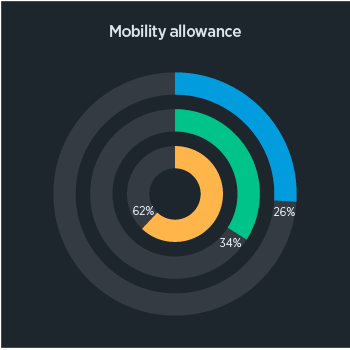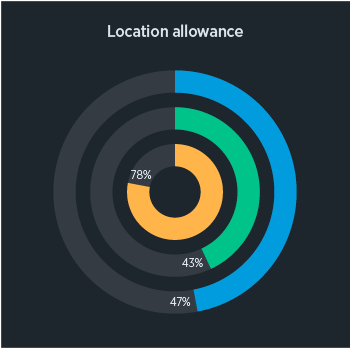When calculating remuneration packages for globally mobile employees, many companies include additional allowances in recognition of the assignment that the employee is about to undertake.
The assignment allowances that companies most commonly provide are mobility allowances and location allowances. They are usually calculated as a percentage of home gross salary but paid net.


 Mobility allowances are paid primarily as an incentive to go on assignment. Companies often refer to them by alternative names such as ‘expatriate allowances’ or ‘foreign service premiums’. The most common mobility allowance is 10%.
Mobility allowances are paid primarily as an incentive to go on assignment. Companies often refer to them by alternative names such as ‘expatriate allowances’ or ‘foreign service premiums’. The most common mobility allowance is 10%.
Location allowances, sometimes called hardship allowances, are paid in recognition of the challenges assignees and their families face when adapting to a new environment. Allowances vary by location in line with the degree of adaptation that is required for a move, and typically reach up to 30%.
It is worth noting that COLA is not considered an assignment allowance. The term COLA stands for ‘Cost of Living Adjustment’ and accounts for the difference in living costs between the assignee’s home and host locations. The purpose of COLA is to maintain assignees’ home country purchasing power while on assignment in the host country, and the amount can be positive or negative – it is a differential rather than an allowance.
Why do companies pay assignment allowances?
Companies have different reasons for paying assignment allowances. The intention may be to compensate assignees, to incentivise them, or to contribute towards monetary costs.
Compensation
Just over 60% of companies who pay location allowances do so as a means of compensating assignees for the difficulties they may face when adjusting to life in the host location. This is certainly the purpose for which ECA’s Location Ratings system is designed. In contrast, only 30% of companies who pay a mobility allowance do so with a view to compensating assignees and their families for the general impact of uprooting and relocating overseas.
Incentive
54% of companies view their mobility allowances as a means of motivating employees to accept assignments. Providing a financial incentive can be an essential recruitment tool: more than half the participants in ECA’s Managing Mobility Survey cited “compensation considered insufficient” as a concern for potential assignees, leading to difficulties with recruitment.
On the other hand, location allowances are not specifically designed to act as an incentive for employees to accept assignments in less desirable locations, but about a third of companies do use them this way.
Covering costs
Only 11% of companies intend mobility allowances to cover the assignees’ miscellaneous expenditure associated with relocating. Presumably this is because most companies provide a dedicated one-off relocation allowance or ‘settling-in’ allowance to assignees at the start of their assignment for this very purpose. Even fewer companies (just 3%) provide location allowances to cover expenditure on practical measures taken to improve life in the host location, e.g. the purchase of air purifiers. Location allowances are in no way designed to reflect the monetary costs of such measures, so it is more appropriate for companies to pay for these separately.
Essentially, the different motivations for providing assignment allowances come to the same thing. Companies pay these allowances to ensure that the package being offered is attractive enough to promote mobility and overcome a candidate’s concerns about temporarily relocating abroad.
When are assignment allowances provided?
When applying the home-based approach
Mobility allowances are paid to assignees by around two-thirds of companies applying the home-based approach. Location allowance systems are even more prevalent; some 78% of these companies have such a system in place.
This is not surprising, given that one of the main reasons companies apply the home-based approach is to ensure that the assignee does not suffer financially regardless of which location they are assigned to. In the absence of a financial incentive such as a mobility allowance, employees may not be eager to relocate. Similarly, if location allowances are not provided, assignees may avoid locations that are perceived to be challenging to adapt to.
When applying the host-based approach
Paying mobility and location allowances as part of a host-based salary system may initially seem counter-intuitive, as a common reason to use this approach is to ensure equity of pay between assignees and their host-country peers (who would not receive such payments). Yet location allowances are provided by 43% of companies applying the host-based approach and mobility allowances by just over a third.
Companies can have different motivations behind applying the host-based approach, however. Topping up a local salary with allowances may be justifiable when the main aim is to promote equity between assignees from different countries working in the same location, or to encourage mobility from high-salary to low-salary countries.
For short-term assignments
Many companies perceive that ‘hardship’, or difficulty adapting to conditions in a particular host location, has an impact regardless of the length of the assignment. It is therefore not uncommon for location allowances to be paid to short-term assignees – nearly 50% of companies do so.
However, relocating on a short-term basis is generally seen to bring less disruption to the assignee and their family than a long-term assignment, particularly as home accommodation arrangements are usually unaffected and dependants are rarely uprooted. Therefore, only a quarter of companies always pay short-term assignees a mobility allowance.
Summary
Assignment allowances are used to incentivise mobility and compensate assignees for the costs and challenges of relocating. Mobility allowances are usually intended as an incentive to relocate, whereas location allowances are designed as compensation for the difficulties an employee may experience when trying to adapt to a new location. Both these allowances are typical elements of the home-based approach, but also feature (less commonly) in other remuneration approaches.
FIND OUT MORE
ECA’s Location Ratings ensure your assignees are appropriately compensated for the differences in adjusting to life in a new country using an objective scoring system that creates equity across your mobile population. Our Location Allowance Calculator provides detailed point-to-point breakdowns of the scoring and a downloadable matrix of allowances for 480 locations.
Many statistics in this report come from our Expatriate Salary Management Survey, which examines trends and best practice in international assignment pay and policy. The next survey opens in April – take part to get a free copy of the results!
Our experienced consultants can provide expert advice about different remuneration models, enabling you to choose the model that best fits your mobility strategy and assignee population. For more information, please get in touch!
Please contact us to speak to a member of our team directly.